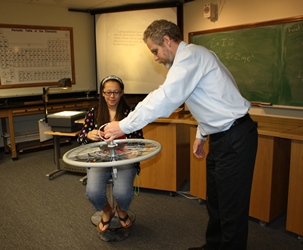Engineering: the Pre-Engineering Program and the Dual-Degree Option

Most students interested a career in engineering and thus in pursuing a pre-engineering path find themselves majoring in physics. There are some exceptions (for example, chemical engineering) but even in these cases a foundational understanding in physics is still essential. For this reason, the pre-engineering advisor is a physics professor who works with the pre-engineering students individually and coordinates their needs with all the relevant departments.
Specific information about the various pre-engineering paths available at Stetson are listed below. Suggested course sequencing for pre-engineering students is outlined in The Physics Major's Handbook.
All accredited engineering schools require their first- and second-year students to take a relatively standardized set of mathematics and physics courses that are commonly referred to as pre-engineering courses. Students who perform well in these courses are accepted into the engineering program of their choice, and they complete the specialized courses associated with that program during their third and fourth years. Stetson does not offer an engineering degree, but we do offer the standard pre-engineering courses, and students interested in engineering have the three options listed below available to them.
Students who choose to attend Stetson while preparing for a career in engineering benefit from the fostering atmosphere of small class sizes and close interaction with faculty, in addition to developing the communications and critical thinking skills that are the hallmarks of a liberal arts education.
OPTION ONE: Students choosing this option complete their first two years at Stetson and then transfer to an engineering school, where they complete their undergraduate work and earn a bachelor of science in engineering. While at Stetson, the students take essentially the same pre-engineering courses that their counterparts at the engineering school take, laying a solid foundation in mathematics and physics, plus the general education courses that are required by the engineering school. Students pursuing this option should obtain catalogs from the engineering schools they are interested in transferring to, and should consult with their advisor so that they can tailor their course selections to match the requirements of the engineering schools.
OPTION TWO (The Dual-Degree Program): Students choosing this option earn Bachelor of Science degrees from both Stetson and an engineering school. Students spend three years at Stetson completing the requirements for a physics major, and then transfer to an accredited engineering school where they are usually able to complete the engineering degree in two years. Upon receiving the engineering degree, they are awarded the BS degree from Stetson. Students are free to complete the dual-degree program at any accredited engineering school. The typical sequence of classes taken by a student pursuing a dual-degree is shown in The Physics Major's Handbook.
OPTION THREE: Many of our pre-engineering students like what they find at Stetson so much that they choose to complete their Bachelor of Science degree in physics at Stetson, and then they pursue specialized training in engineering at the graduate level. Students choosing this option are able to take many more electives in physics and develop a much deeper understanding of the science that underlies the field of engineering they are interested in. They also benefit from having their written and oral communications skills more finely honed. These prove to be an excellent foundation for graduate studies in engineering, and students are able to make the transition with little or no difficulty.
If you have more questions about pursuing a career in engineering, just ask!
Email: [email protected]
Call: 386-822-8910